Abstract
Fifth generation (5G) and Beyond-5G (B5G) will be characterized by highly dense deployments, both on network plane and user plane. Internet of Things, massive sensor deployments and base stations will drive even more energy consumption. User behavior towards mobile service usage is witnessing a paradigm shift with heavy capacity, demanding services resulting in an increase of both screen time and data transfers, which leads to additional power consumption. Mobile network operators will face additional energetic challenges, mainly related to power consumption and network sustainability, starting right in the planning phase with concepts like energy efficiency and greenness by design coming into play. The main contribution of this work is a two-tier method to address such challenges leading to positively-offset carbon dioxide emissions related to mobile networks using a novel approach. The first tier contributes to overall power reduction and optimization based on energy efficient methods applied to 5G and B5G networks. The second tier aims to offset the remaining operational power usage by completely offsetting its carbon footprint through geosequestration. This way, we show that the objective of minimizing overall networks’ carbon footprint is achievable. Conclusions are drawn and it is shown that carbon sequestration initiatives or program adherence represent a negligible cost impact on overall network cost, with the added value of greener and more environmentally friendly network operation. This can also relieve the pressure on mobile network operators in order to maximize compliance with environmentally neutral activity.
1. Introduction
Mobile data services will witness unprecedented usage with the advent of the fifth generation (5G) new radio (NR) and Beyond-5G (B5G) networks. A long way has been paved since the first cellular generations, with the fourth generation (4G) already witnessing a very relevant increase of traffic demand. Nevertheless, 5G will be unprecedented: despite being prepared and designed to be optimized by design, with several energy efficiency (EE) techniques combined with several methods to increase overall throughput and user quality of experience (QoE) and overall quality of service (QoS), B5G NR networks will face a multitude of challenges driven by massive data-hungry subscribers and highly performant end user devices capable of generating enormous amounts of traffic, not solely in downlink but also in uplink. 5G NR and beyond will be fully heterogenous networks (HetNets), with cellular radio access technology (RAT) but also wireless fidelity (Wi-Fi) RAT, where Internet of things (IoT) devices will also play an important role [1]. These networks will have a multitude of different base stations, macrocells, microcells, femtocells, Wi-Fi access points (APs) and relays, making the radio access network (RAN) a very complex architecture. Additionally, a massive number of end user devices are expected to support themselves on 5G NR and beyond, end user or not; e.g., device to device (D2D) or machine to machine (M2M) communications. To support all this, another massification will take place: the deployment of additional mobile base stations, whether they are totally physical or partially virtualized on cloud environments. All of this will make 5G NR and beyond densified networks (DenseNets) [2,3].
All of the aforementioned factors drive the development of new technology, new infrastructures, new processes and network refitting in order to sustain the challenges that are ahead for cellular networks.
From another perspective, mobile services have been witnessing unprecedented growth, bringing new challenges for mobile network operators, from several perspectives:
- Capacity maximization;
- Resource efficiency maximization, particularly spectrally;
- Cost effectiveness and reduction;
- Energy consumption minimization;
- Carbon emissions’ minimization.
With all the changes that have taken place, it is expected that energy consumption will rise also unprecedently in 5G and beyond networks. As such, it is of utmost importance to realize that 5G and beyond cellular networks might be on their way to becoming one of the industries that most contributes to environmental impacts through greenhouse gas emissions (GGE).
From sustainability perspectives, global warming has become a top priority on the word’s agenda [4,5], and cellular systems do have their contribution, which is expected to rise in the future in the form of carbon dioxide (CO2) emissions. Most of the observed increase in global average temperatures is due to the observed emissions of CO2 into the atmosphere. This phenomenon is generally known GGE and occurs naturally, as Earth’s radiant heat becomes trapped in the atmosphere due to existing gases and gets radiated back towards the surface, leading to overall climate changes.
Several studies and governmental initiatives exist that address CO2 emission reduction, primarily those as a direct result of the adoption of the Kyoto protocol resolutions and goals. Although those are out of scope of the current work, CO2 compensation is not, and is the approach that we address in the current work.
Carbon sequestration (CS) is a term that defines the process of capturing and long-term storage of CO2. It is a form of geoengineering, which aims to reduce the impacts of greenhouse gas emissions by manipulating environmental processes in order to counteract those effects. Also known as carbon sequestration and storage (CSS), it focuses on the physical and chemical methods of capturing CO2 from the atmosphere and storing it in another place [6,7]. The most common CSS systems use geological storage, ocean storage or biotic sequestration. In the current article we consider a CSS method to evaluate its capacity of contributing to the reduction of the overall carbon footprint (CF) of normal mobile network operators’ (MNOs’) networks and activities.
Mobile cellular networks’ ever-growing popularity, along with the universe of subscribers which has been increasing exponentially, (and their behavior towards data generation) has become a very relevant contributor to the overall CF [8].
Considering the user plane, the International Telecommunications Union estimated that by 2022, there would be 12.3 billion mobile-connected devices [9], exceeding the world’s projected population of 8 billion by one and a half times [8], with expected further increase in traffic demand mainly driven by mobile gaming and video streaming. In this specific plane, just considering mobile traffic alone, the expected annual growth rate is 46 percent from 2017 to 2022, reaching 77.5 exabytes per month by 2022 [8].
As the numbers of base stations (BSs) and remote radio heads (RRHs) increase due to the unprecedent demand for high capacity and throughput, higher power consumption will occur, and therefore, higher CF. Digital Power Group [10], calculated in a 2013 report that 10% of worldwide electricity generation corresponded to such activities. Other estimations forecast that overall electricity consumption and CF due to such networks will represent 51% and 23%, correspondingly, by 2030 [11].As an example, when considering a 4G macrocell BS, approximately 60% of the power consumption is attributed to the power amplifiers [12], electing it as the most crucial component to consider when energy-centric mobile network design, implementation and operation is the focus.
The wireless industry needs significant improvements in the EE of BSs and other network infrastructure to compensate for the increased energy demands due to network growth [13,14,15]. Therefore, designing energy-efficient communication systems has become a critical issue for 5G and beyond, which promises massive deployments of smart devices served by new infrastructure elements. Especially considering 5G NR, a device will generate an estimated 2.6 times more traffic than a 4G device and this will tend to increase in B5G NR networks [8]. Concepts such as “sustainable green communications” have recently emerged and describe the common trend toward energy-efficient wireless communications systems [16].
Emerging technologies can contribute to reduced power consumption in mobile communication networks, and it is today clear that the telecommunications industry must address CO2 emissions and become more sustainable. The CF concern in the development and deployment of 5G and beyond is clearly one of the most debated subjects today and deserves a closer look.
2. Contribution
The main research question in this paper focuses on existing EE methods and the fact that most do not suffice for achieving carbon neutrality. As such, we address that aspect with a two-tier model, which we present in this work. This two-tier CO2 offset model is the main contribution. The 1st tier applies CO2 reduction through EE techniques, proposed in existing studies aiming to improve overall EE in 5G networks. In that regard, we review the most important contributions in that area and focus on those that maximize CO2 reduction through the overall reduction of power consumption. As mentioned, there will still be CF after applying such techniques, which we call residual CF (RCF).
The 2nd tier has a sole purpose: to offset RCF. Through the methods that will be proposed, this second layer aims to offset RCF by tightly coupling with CF reduction from the 1st tier. It is shown that it is feasible for mobile network operators to effectively offset total CO2 emissions with the proposed two-tier model. Furthermore, the impacts of such an initiative, from capital and operation expenditure (CAPEX and OPEX) perspectives, are also quantified.
The 2nd tier will offset the RCF by applying a CO2 sequestration technique called biotic geosequestration. Trees will be used as carbon-based “sinks” through the process of photosynthesis. The objective is to offset, at least, the RCF produced in the system, considering both the RAN edge (where base stations represent the most energy consuming component) and also the end-user’s equipment operation. In this work, we do not focus on offsetting the CF associated to mobile device manufacturing, datacenter operations and daily MNOs routines related with operational tasks. Nevertheless, all are considered and referred along the work. The focus is the RAN and the mobile device edges, especially considering power consumption associated to base stations and mobile end user devices.
3. Organization
We begin our analysis in Section 4, slightly focusing on the need for EE in 5G and B5G networks. Despite being out of the scope of the current work, we believe that there is enough relevancy on the subject that justifies enumerating some of the techniques that have been developed to reduce overall energy consumption. We argue that such techniques are of utmost importance, representing a first tier of CF reduction because they contribute very relevantly to overall power consumption, and there are methods that transversally focus on all network edges, ranging from the device/subscriber edge/plane to the network edge/plane.
Although EE is very relevant in reducing overall CF, highly dense, heterogeneous and traffic hungry 5G and beyond networks will still result in a relevant RCF after EE deployment. As such, the second tier is focused on in Section 5, introducing the most usual techniques that contribute to overall carbon sequestration and storage. Such techniques will further reduce the RCF from the first tier. Section 6 will focus on estimating the power consumption and CF of both the network and user planes, especially focusing on base stations and end user devices. Based on those estimates, Section 7 presents the method evaluated to demonstrate how CSS can be applied in 5G and B5G cellular deployments, in order to positively offset overall CF and achieve carbon neutrality. Section 8 presents the main results and Section 9 the main conclusions.
4. Energy Efficiency in 5G and Beyond
Two building blocks form the basis for every sustainable system: EE and CF minimization. In this section we focus on some of the most relevant EE techniques which contribute to power consumption reduction, from our point of view.
EE is a term that defines a set of techniques or processes aiming altogether to reduce overall energy requirements. As such, EE can be defined and calculated as the ratio between the quantity of data successfully delivered within a cellular network and the total energy spent in such successful transmission. This means that a system or a component of a system has higher EE if progressively, for the same amount of successfully transmitted data, the energy consumption decreases. It can be expressed as , given by:
where represents the total successfully transmitted data and represents the total energy spent in the successful transmission.
EE plays a crucial role on 5G networks and will be even more crucial on B5G cellular networks in future. As energy consumption of the whole B5G cellular system is expected to increase exponentially, it is of utmost importance to develop techniques that will address that question from a lifecycle perspective.
As such, such a concept must be taken into account right from the design phase on B5G deployments. Thus, it is essential to review some of the most prevalent research works on this field, properly setting the landscape around EE methods for 5G and B5G networks.
Several works have been presented focusing on this subject, reviewing the existing techniques and at the same time stating that energy savings are still far from what would be beneficial and expected [17,18]. Some of the reasons that contribute to such an inability materialize in the shape of several inefficiencies that, when considered altogether, directly impact on overall effort to reduce EE. Some of those inefficiencies are discussed in [19], along with possible and suggested improvements. However, it is also interesting to realize that several smart architectural and topological designs for 5G, which were proposed with resource sharing in mind, offer scalability and flexibility, from a network perspective, but nevertheless, are still insufficient when EE is considered [20,21,22,23].
Clearly, it can be seen that, as stated before, EE should be considered right from the start—in the network design phase. Today, it does not make sense to design a cellular network without thinking about flexibility, scalability and especially EE right from the start.
Overall system efficiency must be evaluated at a system level; i.e., both the network and the devices must be properly considered.
4.1. RAN Edge and EE Methods
As previously said, this work is focused primarily in the RAN edge, where base stations are considered the most energy-hungry devices [24]. Several techniques have been proposed, mainly focusing on selective sleep modes and coverage zooming. The former aims to selectively switch some of the BS’ radio heads, in order to reduce energy consumption according to the traffic profile, which is evaluated continuously. The latter focuses on techniques that adapt coverage radius towards cells where there are BSs in sleep mode, in order to compensate and balance traffic load. Sleep modes have been thoroughly explored in several studies surveyed by [25] which show that: (i) switching radio heads on and off can incur additional energy consumption [26]; (ii) clustering BSs can be very beneficial [27,28]; (iii) considering user experience and quality of service, switching on-off optimization can be achieved, trading off between energy consumption, quality of service [29,30] and quality of experience [31]. Other dynamic operational mechanisms have been proposed using relays, site optimization and dynamic switching [32,33,34,35,36,37].
Regarding coverage zooming, it can be seen as a complement to the above referred-to techniques. Such a technique is very similar to the concept of cell breathing, first introduced with 3G networks, mainly as a result of power control [38,39] adaptation mechanisms. It aims to adjust each cell’s coverage according to traffic conditions [40] and it is computed centrally in the core network. Such a mechanism leads to several benefits that impact the overall EE of the cellular network directly, either by balancing the traffic load between congested and non-congested BSs, or by reducing end users’ power consumption [41].
Several cell zooming techniques have been present and discussed, with the ultimate aim of increasing EE, focusing, namely, on: (i) centralized and de-centralized algorithms [42]; (ii) non-cooperative game theory [43]; (iii) optimal user association [44]. Most recently, the usage of distributed antennas, namely, coordinated multipoint (CMoP) and energy efficient aware continuous cell zooming strategies, has been proposed [45,46]. When considering 5G and B5G deployments, ultra-dense networks must be taken into consideration and density estimation can be used as a strategy for the overall increase of EE, as firstly presented in [47] and subsequently by [48,49]. User density has also been considered as a parameter to smartly reduce overall power consumption [50]. Data-aware mechanisms have also been focused on, relying once again on BS cooperation in order to optimize the overall cell zooming process, and thus, the EE of the whole network 25. Other mechanisms have also been proposed in [51,52,53,54,55,56,57,58].
4.2. Mobile Device Edge and EE Methods
From and end-device perspective, the aim is to reduce as much as possible the power consumption of mobile devices, not only to extend battery lifetime but also in order to increase EE. Such techniques become even more important if one considers the unprecedented number of devices that will be serviced in a cellular network. One can note that today’s behavior towards mobile device usage and consumption patterns has changed radically [7]. Considering, for example, the data exchange between two users which are geographically close to each other, which represents an ever-increasing reality, the possibility of having such data exchange directly between the devices in a D2D fashion can represent several enhancements in power consumption reduction. D2D can be used as a mechanism to decrease power consumption [59,60], by reducing the network hops to only one with the immediate advantage of lower latency; better quality of service and experience; and, from the core network perspective, decrease signaling and overall backbone traffic. Additionally, and probably the most obvious advantage, is that both devices will need less power to transmit the same amount of data, thereby directly increasing EE by reducing energy consumption. However, mobile devices still do not have enough battery life or computational capacity to allow them to perform effectively over long periods of time, which is a requirement for most users. Additionally, for those applications that need high communication or computation power, and low latency, performance will drop severely. As such, an interesting concept has appeared called cyber foraging [61] or computational offloading. Cyber foraging is a technique that enables end user devices to extend their computing power by offloading computation efforts or data processing to more powerful servers located in the cloud, or sometimes, as close as a single hop away. An extensive survey on cyber foraging techniques has been presented in [62], showing clearly the advantages of using such techniques for end user plane’s power consumption reduction. Recent studies denote that cyber foraging is still an immature concept from a standardization perspective and have proposed methods and models for its implementation together with protocols for cyber foraging user plane functions [63,64].
4.3. Overall EE Contribution for CF Reduction
For many decades, mobile network operators focused their attention on network optimization and increasing data throughput, special coverage and reducing latency. However, in today’s cellular networks, energy consumption reduction (and EE overall) has become one of the prime objectives, due to environmental and economic aspects. We have briefly covered several techniques that show that EE maximization is possible at a network level where there is a set of such techniques and mechanisms already proposed. We have also noted that not only does the network plane need attention, but the end user plane does also, especially the devices themselves. We have presented some of the main techniques that are being discussed in order to minimize power consumption on the end user plane, leading to overall network power consumption reduction.
Current studies indicate that the level of carbon emission due to communication and information technologies has reached up to 10% of overall CF, of which 2%–3.5% corresponds to mobile networks [65,66,67]. There is no doubt that, considering the actual trends, such values will rise exponentially with the massive requirements of 5G and B5G networks. This means that since, at a given time, EE techniques may cease contributing relevantly to reduce overall carbon emissions, an additional approach must be considered to further reduce overall network CF. It is natural, thus, that CSS techniques and offsetting become the natural second tier in order to achieve a greener cellular network operation. The next section will focus on existing techniques to capture and store CO2.
5. Carbon Sequestration and Storage
CSS is a process that aims to capture atmospheric CO2 and store it over the long term, thereby reducing the overall greenhouse gas (GHG) emissions. It consists of actively removing CO2 from the atmosphere into reservoirs, which can be man-made or natural. In this work we focus on the natural ones, which can be split into several types: biotic (e.g., trees); geological (e.g., underground rock formations and structures); oceanic (e.g., underwater bolsters); and underground sinks, such as saline deposits or gas reserves [68]. Each one of these is important and their main objective is to reduce the overall GHG emissions, taking advantage of natural processes to achieve that goal.
In this work we focus on biotic or biomass CSS, as it is the only one which does not require the development of technology to fulfill its task. Interestingly enough, one of the major contradictions is developing technological methods for reducing GHG emissions without considering that those technological processes themselves contribute to generate additional GHG emissions. As such, the next sections briefly introduce the concepts.
5.1. Geological CSS
Geological CSS is a method for capturing and trapping CO2 in appropriate rock formations, mainly underground [69]. The capturing process is done in a gaseous form by using physical and chemical methods. Trapping is performed by underground or underwater geological formations, injected by pipelines, but mainly used on underground rock formations [70]. It is a technological process that also creates by itself additional CO2 emissions and has several drawbacks: rocks have to be carefully chosen; CO2 can leak into the ocean or surface, causing an impact on marine fauna or generating bolsters of CO2 near the surface with severe impacts on animals and plants.
5.2. Ocenan CSS
Ocean carbon storage is very similar to geological CSS, but is accomplished totally underwater; namely, in the oceans. The CO2 is injected in underwater rock formations or bolsters [71]. There are several setbacks to this method, including endangering the environment itself in a harsh way. Ocean water might suffer from acidification when CO2 is leaked from the ocean beds, reaching the atmosphere anyway. It is a process that requires advanced technological processes in order to keep pumping and keep the pressure stable, to avoid CO2 leakage [72,73].
5.3. Biotic CSS
As referred to, the previous two methods present several risks and are not considered very effective, acceptable or sustainable approaches for CSS. Therefore, an alternative is needed, which does not have so many risks, does not involve the use of technology during the sequestration period and, if possible, can increase the CO2 storage over time.
This is where biotic sequestration, or tree-based sequestration becomes the chosen method. In this case CO2 is trapped through the natural process of photosynthesis [74,75,76,77]. This means that during the capture part there are no setbacks and no side effects, as it is derived from a total natural process.
Trees retrieve CO2 from the atmosphere and store it in several of their parts, including trunks, limbs, leaves and roots. This behavior constitutes a CO2 storage technique, as it is removed from the atmosphere and trapped inside the tree. Additionally, as mentioned, there is the possibility of the same tree increasing its storage capacity: as solar exposure increases, more photosynthesis will occur, and more CO2 will be extracted from the atmosphere and converted into biomass, below and above ground, in the tree itself [78,79,80]. Photosynthesis converts the energy from sunlight into nutrients that the tree requires and keeps, transforming CO2 and water into oxygen and glucose [81,82].
This means that the CO2 storage capacity increases, but only to a certain degree. When the tree becomes older, its storage capacity ceases increasing and remains constant. Nevertheless, as it will be shown in this work, this depends on the type of tree and happens two or three decades after the tree has been planted [83,84,85]. Table 1 presents the breakdown in percentages of the total system CF and an estimate each for 2020 and 2025, considering a linear increase of 11 MtCO2-e per year.

Table 1.
Carbon footprint (CF) breakdown per system component—2020.
6. Energy Consumption for RAN and Mobile Edges
This section focuses on CF estimation for both network edges under analysis in this work. After overviewing different proposed EE techniques for both edges, as previously referred to, even after being deployed, there still is RCF that needs to be addressed through a second tier. In order to understand how EE contributes to reducing overall power consumption on both edges, it is crucial to understand what the consumption levels are on both edges first. As mentioned, we will focus on RAN and mobile edges.
6.1. RAN Edge Power Consumption
Regarding base stations, [86] showed that at full system load, the power consumption of a 5G BS can range from 6 W to 1 kW, depending whether it is a femtocell or macrocell, respectively [85,86]. The main reason for a macrocell to have higher consumption than a 5G femtocell is related to the need to cover wider areas, and thus employing higher capacity power amplifiers, which require more power than femtocells. For the latter, the majority of the power consumption comes from the baseband units [86,87]. Nevertheless, the interesting part is that these units can be disaggregated from the radio elements and virtualized in a C-RAN environment. Just by residing in cloud environments, with the help of NFV, each can be seen as a single virtualized function that can be virtually aggregated, contributing overall to a power reduction on the femtocell side [74]. Such an approach might also be applied to gNBs in 5G NR and beyond networks, considering that NFV combined with the usage of C-RAN principles and cloud edge computing would result in minimizing such power consumption. As such, for beyond 5G networks it is expected that, with the huge massification of small cells, overall power consumption can drop simply by virtualizing part of its functionality. Such functions are not the aim of this work, but it should be noted that NFV and edge computing are two paradigms for beyond 5G NR networks that will certainly contribute to overall power consumption reduction. For the objectives of this work, we will consider the power consumption values previously referred to. According to [24], dense deployments of BSs result in excessive energy consumption levels which can rise up to 60 billion kWh per year.
6.2. Mobile Edge Power Consumption
In both 5G and B5G networks, end devices can be classified under two categories: human-interaction enabled and human-interaction free. The former relates to what are known as smartphones, while the latter relates to all devices able to generate a communication flow, either unidirectional or bi-directional, without any human interaction. Sensor networks and machine-to-machine (M2M) communication fall into this category which is not within the scope of the current document, and thus will not be discussed. On the other hand, smartphones play an important role regarding energy consumption and will be taken into account in this work.
Considering the very relevant and rapid advances in technology, especially as processing capacity and hardware components become more advanced, with sometimes physically larger devices (e.g., touchscreens), energy consumption rises. On the other hand, the number of subscribers has been growing dramatically, demanding quicker access to the Internet, more bandwidth consuming services and applications often requiring near real-time operation. Both will contribute very relevantly to the rise of energy consumption, and consequently, will increase overall CO2 atmospheric levels and CF. If one considers the estimate that by 2030, there will be more that 50 million connected end user devices, the resulting global CF may become very relevant [88]. Thus, it is of utmost importance to focus on end user devices from this perspective.
Smartphones do not consume energy in a uniform way. Several of their components have different energy consumption needs: usually, during a call, the RF module is the most energy consuming component, whereas the display might become the highest consuming component if video streaming is being used. On the other hand, smartphones often have different operation methods; namely, suspended (when the application processor is idle but the communications processor remains active in background), and the idle state, which is similar to the suspended state, but the display is active and the whole graphical subsystem and processing components. In these two operation modes, the levels of energy consumption are different, with the RF module consuming the most in the suspended state and the display and graphical processor being the most energy demanding pieces in idle mode. Average power consumption figures (excluding the backlight) for three different smartphones have been focused on extensively in [89]. It was shown that when localization services are active and running on background, GPS radio is active and contributes to overall consumption, increasing it. If one considers real time for services such as cloud music streaming, several components will always be active at the same time, raising the level of energy consumption.
Therefore, it is safe to state that smartphone energy consumption profile is heavily dependent on the type of behavior of the subscriber, which implies certain working characteristics, ultimately depending on the types of applications.
Besides application dependence, energy consumption also depends on the brightness level required by the application itself and can increase power consumption 66 times more [89]. Power consumption models have been proposed for LTE and LTE-A, and it was shown that the downlink data rate (closely related to applications and downlink streaming services) and uplink transmission power are the two most consuming factors. It was also shown that LTE RF module’s power consumption varies according to operating bandwidth, up to three times more when working on 15 MHz band compared to 10 MHz [90,91].
Interestingly enough, different smartphone vendors or different brands are also factors to account for, as power requirements and consumption might differ relevantly. Even within the same vendor, different models can have different consumption values. To demonstrate such behavior, we rely on Apple’s Environment Reports (AER).
Apple considers a three-year life cycle for their iPhone devices. The results from several AERs, presented on Table 2, show that, in terms of power consumption per year, the minimum value is about 3.6 kWh/year and the maximum is 10.5 kWh/year, for the iPhone SE 32GB and iPhone X 256GB, respectively, according to the 2017 AER. In terms of equivalent carbon dioxide per year, a minimum of 1.8 kgCO2-e/year and a maximum of 5.3 kgCO2-e/year corresponds to the indicated power consumption. These values are close to results from other studies, which estimate average values of 4.5 kWh/year and 2 kWh/year per smartphone [92,93]. Considering the whole smartphone’s life cycle, the total equivalent carbon dioxide footprint ranges from 45 kgCO2-e/yr to 100 kgCO2-e/yr, though is typically 40 kgCO2-e/yr according to [94], which is the reference chosen in this work.

Table 2.
CF breakdown per apple smartphone.
On the other hand, another distinguishing factor regarding energy consumption depends heavily on usage patterns. Human usage habits will imply different power consumption patterns. With increasing unbounded access to data and real time data sharing between humans themselves and machines (e.g., M2M communications), energy hungry behavior will manifest itself through the usage of data and power consumption hungry applications, especially multimedia communications and real time collaborative gaming [12].
6.3. Overall Network Consumption
In order to provide a notion of the amount of CO2-e and the global CF that a mobile communications network is estimated to have by 2020, according to [95] the overall CF will be 235 MtCO2-e, and it will be 290 MtCO2-e by 2025. But, more than the value itself, it is relevant to understand the breakdown of such value. As such, there are mainly six components in a cellular network that contribute to the total amount of CO2-e produced per year: (i) mobile device manufacturing; (ii) mobile device operation; (iii) RAN sites’ manufacturing and construction; (iv) RAN sites’ operation; (v) MNO activities; and (vi) datacenters and data transport.
Most recently, the latest estimate of energy consumption of mobile networks circles around about 130 TWh/yr, representing a CF of 110 MtCO2-e/yr for edge RAN alone, added up by 90 MtCO2-e/yr from the mobile edge (including manufacture and use), totaling 200 MtCO2-e/yr [96]. The results from [96] confirm, in a way, the estimations from [95].
This work focuses solely on RAN and mobile computing edges. This means that from Table 1 only three components will be considered, contributing to a total of 43% of whole CO2-e produced in one year. This value is obtained from summing the components related to RAN sites’ operation (RSO) which results in 29%, plus the RAN sites’ manufacturing, corresponding to 4%; and finally, mobile device operation representing 10%, as presented in Table 1.
Additionally, we assume that RAN specific RAN sites’ operation and RAN sites’ manufacturing can be integrated into a single variable which reflects all RAN CF. All CF calculations can be expressed through the following equations:
where represents the carbon footprint related to the RAN edge; represents the remaining CF related to all other components; represents the CF related to mobile device operation (see Table 1) and
with CFX representing the carbon footprint related to component X, which can be extracted from Table 1.
In our case, we have considered an edge approach, and as such, we consider the following overall CF:
For the considerations and assumptions of this work, the total amount of CF that must be offset and neutralized will be the sum of both edges we are focusing on
where represents the total carbon footprint for both RAN edge () and mobile edge ().
From what is shown, it can be seen that to meet the objective of turning both edges carbon neutral, successfully reducing and offsetting CF on both (, the overall consumption and CF must be reduced by 43% of the total estimated CF ( for 2020 and 2025 (Table 1). In this case we have
where and represent the weight or percentage of contribution for overall CF from RAN and mobile edges, respectively.
Resuming, the total amount of CF that needs to be addressed in 2020 is a total of 101.05 MtCO2-e/yr and 124.7 MtCO2-e/yr by 2025, corresponding roughly to 43% of the overall CF (29% + 10% + 4%) for the corresponding years.
As mentioned, the proposed model is a two tier one, meaning that EE and the carbon offset method in conjunction need to be able to reduce and offset 43% of the overall considered CF. Nevertheless, these are estimated world consumption values, in megatons, meaning that it is important to understand how the whole offsetting process works and how much biotic sequestration it takes to offset the CF of individual elements, such as a base station, a femtocell or an individual smartphone.
7. Carbon Sequestration Estimation
In this section we present the 2nd tier of the proposed method, which consists of CO2 sequestration and storage in order to offset the RCF after applying the 1st tier EE, previously described.
As mentioned, biotic CSS is considered in this paper. Following our previous work [7], the CSS method is the same in the form of tree planting. For simplicity of the model we do not consider climate changes; tree species, age or size; growth rates; or soil type. As such, we base our proposed methodology on the official UK program called UK Woodland Carbon Code, which is managed by the Scottish Forestry, a Scottish Governmental Agency. This agency is responsible for forestry policy, support and regulation, on behalf of the Forestry Commission in England, the Welsh Government and the Northern Ireland Forest Service [97]. Prior to April 2019 the sequestering data and characteristics were different from the ones today and have been enhanced. This presents us the opportunity to further enhance the model and contribute to the climate effort of reducing GHG emissions or achieving carbon neutrality.
Another different perspective from our previous work is that, considering the objective of the current work and in particular the existence of the first tier of EE, instead of considering collective CSS, we will adopt individual CSS. This means that, instead of assuming two different species as before for carbon offset calculations, we consider only one tree species, the Fagus sylvatica, commonly known as beech (BE). Nevertheless, in this section we compare it to conifer species (CON), to comprehensively clarify why BE was chosen. Starting with Figure 1 it is shown that BE has overall more capacity for CSS than a CON over a period of 5 years, as considered in [97]. Spacing and density will still remain the same, which are the two factors that maximize CSS, according to the data from [97]. A second objective of this work is to understand individually, the impact of a single BE tree over the course of a five-year lifecycle period.
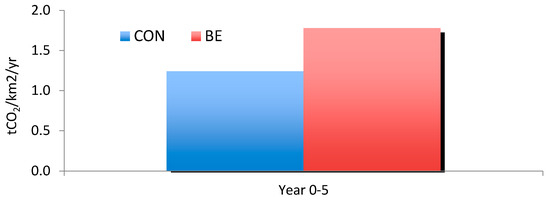
Figure 1.
Total CO2 sequestration capacity in the first five-year period.
Methodology and Assumptions
From the Woodland Carbon core initiative, one can extract data about estimated capacity of biotic sequestration for certain types of trees from establishment to a total of 200 years. The reporting timespan is divided into 5-year periods, with the aim of minimizing the yearly variation in growing conditions. This means that uniform growth is considered per month, for one year. In the following we will focus solely on the first 5 years. Table 3 shows the assumptions based on the information obtained from [97]. Another assumption is about the type of tree itself. We aim to extract the most CO2 out of atmosphere as possible, and in order to do that we have considered broadleaf (BL) or hardwood, a type of trees that has a high capacity of photosynthesis and, thus is able to sequester high amounts of CO2. Additionally, this species is the one that is most fit to European regions, considering the climate [97]. Another option would be conifer, but their capacity of retaining CO2 is lower when compared with BL.

Table 3.
Individual sequestration and storage (CSS) model parameters.
It can be seen from Figure 2 that in the first 5 years BL is able to sequester more than CON; namely, an average of 133%/year over the course of the first five years. Especially one year after establishment, one hectare of BE is able to sequester 167% more CO2 than the CON. The lookup tables also consider tree thinning. In our case, we do not consider that, because according to the data, it is performed after the first 5 years, while the focus of this work is the first five years [97]. Nevertheless, the existing data also shows that the highest CSS capacity occurs while the trees are not yet mature, up to 35–40 years, and still, from a CO2 sequestration capacity perspective, BL is superior to CON over that period, as shown in Figure 2, Figure 3 and Figure 4, illustrating the thinning effect on CO2 sequestration, which basically does not exist until right before a tree becomes mature, at around 25–30 years old [97]. As such, that effect is not considered in this work.
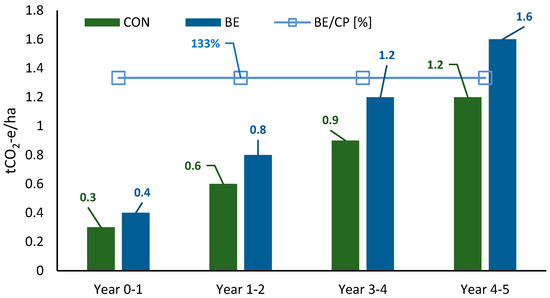
Figure 2.
Per year sequestration capacity comparison between broadleaf (BL) and conifer species (CON) in the first 5 years.
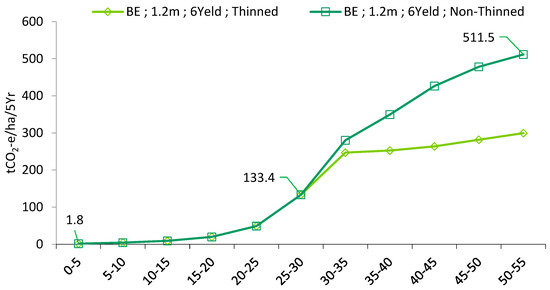
Figure 3.
Cumulative carbon standing over time—BL.
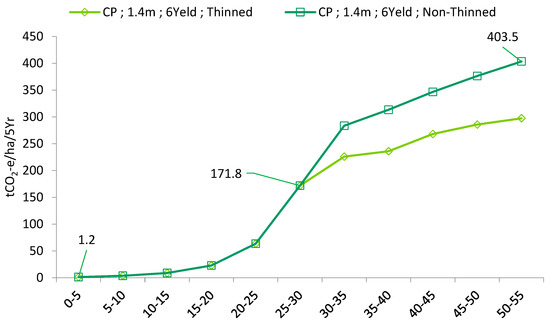
Figure 4.
Cumulative carbon standing over time—CON.
With reference to the above, a comparison can now be performed between BE and CON in the first five years, considering uniform growth rate and CO2 sequestration capacity during the first 5-year period. Table 4 presents the values that will be considered, from that assumption.

Table 4.
Individual CSS model parameters.
From Table 4 one derives the information that will become the baseline for the study from now on:
- BE will be considered solely because it is the species that can sequester most CO2 not only in the first five years but also in long-term, as depicted in Figure 3;
- Each hectare has approximately 6700 trees considering a tree spacing of 1.2 m;
- All the 6700 BE trees have the ability to sequester 400,000 kgCO2-e/yr per hectare;
- One single BE tree, considering the uniformity previously referred to, can sequester approximately 60 kgCO2-e/yr.
These are the fundamental parameters and corresponding values used from this point on. The next section will discuss two types of results: understanding how many trees are needed to individually sequester the CFs of a smartphone, a femtocell and a microcell; applying the methodology to a small example 5G NR network in order to understand how both tiers will work.
8. Results and Discussion
As previously referred to, the focus here will be two-fold. First an analysis of the ability to offset individual components will be shown. Secondly a small network simulation will be performed in order to understand how to carbon offset the whole system, achieving carbon neutrality.
Arriving at this point it is important to understand that, as mentioned before, on average EE methods are able to reduce 10% of overall energy consumption. Therefore, we assume a 10% overall reduction of CF due to EE methods. In the third and last subsection an example of a network model is presented, where the two-tier CF reduction methodology is applied, and results and discussion are presented.
8.1. Individual Analysis
We have considered the typical CF of a smartphone life cycle (which is 5 years, aligning with the 5 year period of biotic sequestration that is being considered), which is very close to that we have observed on average in Apple devices that were studied, as presented in Section 6.2 [94].
Table 5 presents a summary of the relevant parameters that were considered for this part of the analysis, considering only RAN and mobile edges, as previously referred to.

Table 5.
Average values of individual CFs.
The values for the CFs of both Femto and Macrocells were extracted from [7], assuming an uptime of 8765 h/year and a total power consumption in full load of and , and considering the annual CO2 mass equivalent per kWh in Europe . Having characterized the level of CF that each component represents, one can apply the EE and the CSS methods, knowing that
where
which means that EE will be responsible for reducing 10% of overall CF for all components in both edges and CSS will have to try to offset the RCF which is 90% of the whole CF of each element.
Table 6 shows the amount of CF that each tier should perform.

Table 6.
CF reduction per tier.
As such, the values that CSS should reduce are the ones referring to Tier 2. Considering that a single specimen of the considered trees is able to sequester and store approximately 60 kgCO2-e/year, some initial conclusions can be drawn:
- One single BE tree can offset in one year an amount of CF equivalent to:
- ○
- The yearly CF of four femtocells or;
- ○
- The yearly CF of one smartphone.
- After 5 years that single BE tree is able to offset the equivalent to approximately 300 kgCO2-e during that year, an amount equivalent to:
- ○
- The yearly CF of 22 femtocells or;
- ○
- The yearly CF of eight smartphones.
Figure 5 depicts how the CF sequestration and storage evolves for a single tree in the first five years. As mentioned, it has a linear and uniform increase per year. Such a CSS increase allows one single tree to offset the yearly CF from one to eight smartphones, or, equivalently, offset the yearly CF of 2–22 Femtocells. It also shows that a single BE tree is not able to neutralize the CF of a single macrocell. At its peak in year 5, the CSS of 299 kgCO2-e/year of a single BE tree represents only 13% of the whole CF that a macrocell represents. Anyway, if one were to consider partial carbon neutralization, a single tree would partially neutralize 13% of the macrocell’s CF. This is related only to the 2nd tier. If one considers the two tiers, EE plus CSS, that value would increase to 23% (10% EE plus 13% CSS). At an average cost of $0.1 (0.09€) /tree, which includes maintenance according to [98], offsetting 23% of a macrocell’s CF would have very low and negligible CAPEX (without considering terrain costs, which we do not focus on in this work). Regarding the macrocells, the question is how many trees would it take to totally offset a macrocells’ RCF and achieve carbon neutrality?
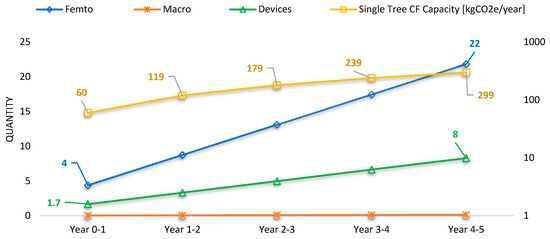
Figure 5.
Cumulative carbon standing over time—CON.
If we increase the biotic RCF sequestration capacity by adding additional trees, it easy to see that to fully offset a 5G NR macrocell and achieve carbon neutrality, 40 trees would be needed, as depicted in Figure 6. As it can be seen, in order to completely compensate the CF of a macrocell right after being deployed, 40 trees would have to be planted, and carbon neutrality for that macrocell would be achieved after one year.
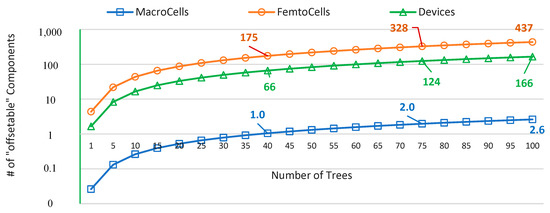
Figure 6.
Number of trees required to archive carbon neutrality for each element.
Alternatively, those 40 trees could also be considered as the necessary amount to achieve neutrality of 175 femtocells or 66 smartphones. Most importantly, the cost to make a 5G NR macrocell carbon neutral would be around $4.
Another interesting analysis that can be done is whether an MNO should expect to be carbon neutral from the start or plan a program. Figure 7 shows the difference. As it can be seen, if an MNO plans to achieve neutrality, for instance for 10 macrocell at year 0, the number of trees that would be needed is much higher due to their lower CSS. On the other hand, if the MNO plans to achieve neutrality in 5 years when each tree achieves a five times greater capacity for offsetting CO2, then it would require less trees to be planted on year 0 and the CAPEX would be greatly reduced. For the extreme case of deploying a 1000 macrocell network and planning to achieve neutrality for all, the difference between doing it immediately (referred as greenfield in Figure 7) or planning to achieve so in a five-year horizon represents one fifth of the cost.
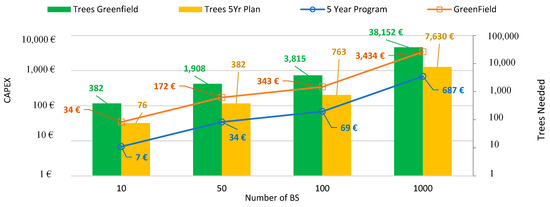
Figure 7.
Capital expenditure (CAPEX) difference between 1st year offsetting and a 5 year program.
As such, proper planning for carbon neutrality makes sense, especially if one considers the lifetime of the biotic elements and the fact that up to 35–40 years after initial establishment, this kind of tree continues to increase its CO2 sequestration capacity.
The MNO can perform its planning from a different perspective, without considering terrain costs, maintenance and other operational aspects. It can develop a partnership with a city hall’s government in order for them to plant and maintain the biotic mass within cities; existing terrains; or, e.g., alongside roads and highways. This is an example of a shared business model, which can present very interesting results, and still the MNO will be able to offset very relevantly its CF. Our model shows that, as an example, if one considers a highway of 25 km, BE planting could occur alongside the highway itself and on the central part splitting the lanes in both directions. This would represent, roughly, 75 km of BE planted at a spacing of 1.2 m, resulting in a CSS capacity of 1.12 MtCO2-e/year or, in other words, the carbon neutrality for 540,000 smartphones. The overall investment in biotic mass would be around 15,900€.
A second approach can be indirect, through the adoption of a carbon offset program. Carbon offset programs are becoming more and more available, allowing companies to invest in biotic sequestration indirectly. This method is not only the greenest but creates revenue for people involved in it by giving them jobs. For the sake of this work, two simple examples are given from [99], where a donation program helps to create an offset program.
One example is the donation of $100, roughly 90€, according to which the program will plant 1000 seedings which results in a capture capability of the equivalent to 40,000 kgCO2-e/year after 1 year. Such an amount, considering the same type of tree, would be enough to achieve total neutrality for 17 5G NR macrocells, 2930 femtocells or 1110 smartphones.
A second program consists of donating $640, roughly 576€, and the program will create a forest with 6,400 trees in order to offset the RCF. This value represents an amount of 256,000 kgCO2-e/year of carbon sequestration, which can, after five years, represent 1.28 tCO2-e/year. These 6400 trees are roughly the same number as on the Woodland Carbon Code Forestry program, referred in the previous sections, which can sequester from 400,000 kgCO2-e/year on the first year to 1.8 tCO2-e/year in the 5th year after planting. This represents the same to a hectare of 6700 BE separated 1.2 m apart. In this case the amount of sequestered CO2—for the first year—would allow in bulk to offset and achieve carbon neutrality for 176 macrocells, roughly 29,269 femtocells and 11,100 smartphones, approximately.
If an MNO considers investing a whole hectare, for a 5-year CO2 offset program starting with a CO2 sequestration capacity of 400,000 kgCO2-e/year on the first year and finishing 1.8 tCO2-e/year, the result would be as depicted in Figure 8.
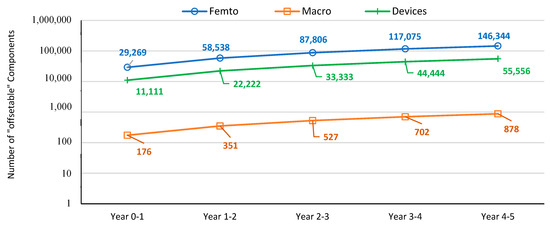
Figure 8.
Number of edge components that can be offset per type in a 5-year CO2 offset program.
An MNO that invests in a hectare for instance, to achieve carbon neutrality after five years, in the first year will be able to successfully achieve carbon neutrality for 176 of its macrocells, and in the 5th year, for 878 of its macrocells.
As an example, a small MNO that wishes to introduce femtocells to enhance the capacity of its already EE optimized 5G NR network, can plan its femtocell deployment according to its capacity to achieve carbon neutrality, deploying roughly 29,270 in the first year, and doubling up its capacity year after year until reaching the 5th year, where a total of 146,344 femtocells would be deployed and still achieve carbon neutrality.
If we consider the life cycle of a whole cellular generation with the duration of 10 years, the same trees can still be maintained because, as mentioned previously, the trees will still be increasing their CO2 sequestration capacity up until 30 years old. Figure 9 shows the increase in the number of different element types that could be supported and still be carbon neutral after 10 years. It is important to note that those three categories do not add up; i.e., on the 10th year the amount of CO2 that can be sequestered is 4.5 tCO2-e/year, which is enough to achieve carbon neutrality for each one of the represented elements independently—either macrocells, femtocells or devices—but not the sum of any of these components. If one wants to offset all three components, one would have to, in theory, consider a program with a total of 13.5 tCO2-e/year after the 10th year, which would cost three times more; i.e., roughly 1730 €. The mixture of a different number of components will be presented in the next subsection, where a simulated scenario is considered.
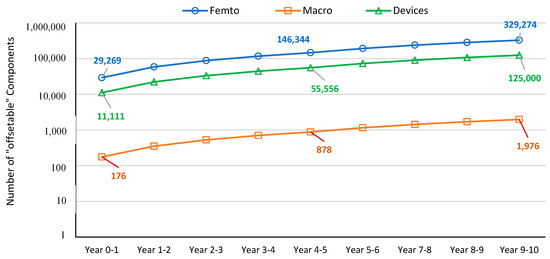
Figure 9.
Number of edge components that can be offset per type in a 10-year CO2 offset program.
8.2. 5G NR Deployment Scenario
Accelerated roll-out of 5G NR gives MNOs the opportunity to prevent escalating network energy demand, as it is expected drive to an increase in CO2 emissions due to unprecedent larger traffic volumes.
By accelerating 5G NR deployments, but especially, preparing for B5G networks, MNOs can set and meet targets from regulators regarding their total CO2 emissions. That is the main reason why this work focuses on a two-tier mode is that it allows for a first step of energy reduction through network EE and secondly CO2 emission reduction. With this in mind, in this subsection we present a very simple model of a 5G NR network and focus solely on the number of elements of both edges under analysis. As such, several assumptions are made in order to simplify the system. It is not the aim of this work to fully depict a 5G NR or future network architecture.
The first assumption is related to femtocells: we consider that less than 10 femtocells per cell is not considered a 5G NR DenseNet deployment; at least 10 femtocells should be considered per cell. The system is comprised by a logical hexagonal shaped cell with a gNB in the centre and several spread femtocells, as previously referred to. The total number of cells is seven. Figure 10 is a snapshot of the scenario, where users are considered to be mobile. This sets the baseline for users, considered to be randomly distributed along the different cells. This perspective makes sense from the strict point of view of calculating CF. The whole system is considered to have EE techniques deployed, which will bring down overall power consumption by 10%, thereby reducing equally, the overall CF by 10%.
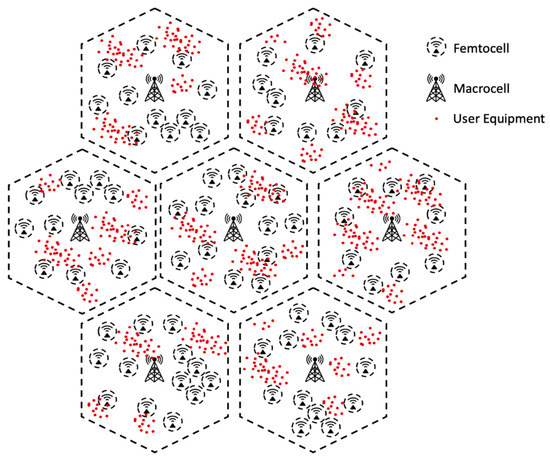
Figure 10.
Example system model.
For the sake of simplicity, we do not consider the existence of Wi-Fi access points which might also be considered in a multi-RAT 5G NR deployment.
We define and as the set of M macrocells and F femtocells within our proposed scenario, respectively. Particularly, let us define the index of a generic base station and also , as a generic user device belonging to the subscribers set
Considering the power consumption of all elements described in previous sections, which are present on the RAT edge, the total CF is given by:
From the same perspective, the CF on the mobile edge is given by:
The total system CF is given, therefore, by:
where we consider the amount of femtocells per macrocells. We also consider subscribers in the system, performing high traffic demanding usage of their smartphone, with a mean value of 2000 subscribers per cell.
For the considered system, the CF is evaluated as depicted in Figure 11. From Figure 11, the total CF of the whole system can be obtained as
and the RCF after applying EE as the 1st tier is given by
where represents the reduction factor due to the application of EE technologies to the whole system.
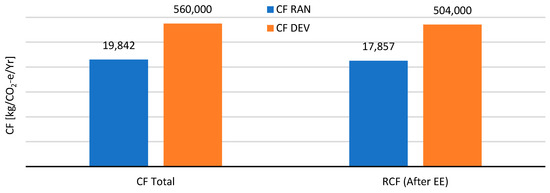
Figure 11.
Total CF for the system before and after energy efficiency (EE) 1st tier reduction.
The remaining CF must then be handled by the 2nd tier, which is assumed to be biotic CSS. It was previously explained that a whole hectare of around 6700 trees is able to offset 1.8 tCO2-e/year. At this point two different scenarios may be addressed by the MNO: offset immediately all the CF of the system; or progressively reduce it, in a 5-year time span, allowing the trees to increase their capacities and reach the required value after 5 years.
To completely offset the current CF value of 521,857 kg/CO2-e/year, the whole CF consumption is 30% above the CO2 offset capacity of 6700 tree in the first year. In order to completely offset that value, an additional capacity of 122,000 kg/CO2-e/year is required. This represents the need for an additional 2,333 BE trees, totaling 8700 trees, with an added price of 183€. As such, the cost for becoming carbon neutral through biotic CSS is 786€.
If the MNO decides to not offset completely in the first year and not invest in additional carbon sequestration capacity (more trees), for example, due to possible high terrain costs which we do not consider in the current work, it can simply wait for the overall capacity to surpass the system target CF, which will occur later-on, assuming this remains constant. In that case, in the first year, 69.5% of the whole CF of both edges is offset and the MNO can wait for trees to grow their storage capacity, as depicted in Figure 11.
As it can be seen from Figure 12, shortly after the first year has passed, the amount of CSS capacity surpasses the requirements for the system, and carbon neutrality is achieved after approximately 1.5 years with an initial CAPEX of 603€, corresponding to one hectare of 6700 BE trees. Nevertheless, it was considered that the CF of the system remained constant during the 5 years. This might be a little unrealistic, as the number of subscribers rises, and it might be necessary to deploy additional base stations.
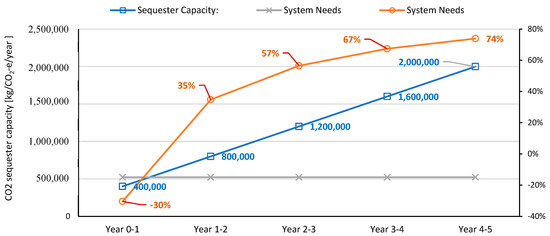
Figure 12.
Evolution of CSS capacity for the first 5 years.
In that regard, if we consider several percentage points of CF increase per year, how many years would it take the MNO to achieve carbon neutrality without any additional costs on the biotic sequestration?
As it can be seen from Figure 13, if we consider 100% as being the total carbon offset capacity, any value above that means that the scenario is over the maximum CSS capacity. For example, if one considers 10% of CF rising every year, on the first year it is 44% above maximum CSS capacity (144%), but on the second year, carbon neutrality is achieved because the maximum CSS capacity has increased due to trees increasing their CSS capacity. In this case, the system overall CF represents only 72% of the overall CSS capacity. This means that carbon neutrality has been achieved and there is still 28% carbon credit.
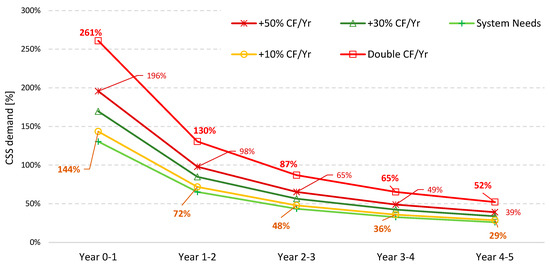
Figure 13.
CSS demand considering system’s CF increase per year.
Even if the CF rises 50% or doubles each year, which is something hardly expected in future beyond 5G networks, the increasing sequestration capacity would still be able to compensate and carbon neutrality would be achieved on 2nd and 3rd years, respectively. Note that when we are considering an increase in CF, we assume all components to increase equally in the whole network, as presented in Table 7.

Table 7.
System residual CF (RCF), neutrality and system expansion.
What Table 7 shows is that even if the MNO decides to double the number of cells, from 7 to 14, and doubles all components, both tiers will be able to compensate for that growth, and particularly, carbon neutrality is still achievable after the 3rd year of operation, for both edges. In this case, the CAPEX remains the same, approximately 600€, which is the initial investment in one hectare of BE separated 1.2 m apart. This cost is negligible for any MNO, without considering the terrain costs, which can play a relevant role in the whole cost structure. However, for the sake of simplicity and demonstrating the advantages of dual tiering for achieving carbon neutrality, we do not consider terrain cost.
Finally, it is interesting to evaluate on the 5-year time span the maximum expansion that the network system used as a reference would be able to achieve, while still being carbon neutral. It can be seen from Figure 14 that the maximum CF yearly growth that can be supported by the existing biotic CSS is 3.5 times, still with 9% of CO2 credit. If the chosen reference system is quadrupled, the existing biotic sequestration is not enough anymore, carbon neutrality will not be achieved within the 5 years and a minimum of an additional 4% of CO2 offset is needed. This can be achieved by acquiring additional biotic capacity, or the MNO has the possibility of choosing to increment the number of years to 6, still taking advantage of the fact that the existing biotic capacity will grow for many years more, as previously explained. It is important to note that, although we have mainly focused ourselves on the first five years, for simplicity and because it is the life cycle period considered for smartphones, CSS capacity would still continue to grow for up to 30/35 years. This means that there would be room to accommodate higher values of RCF as the years advance, still maintaining carbon neutrality.
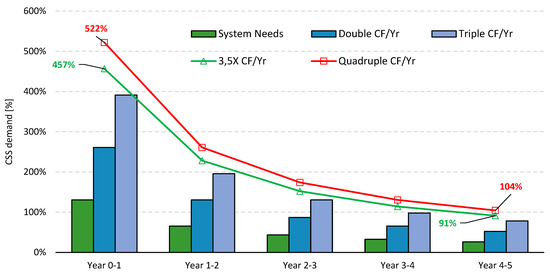
Figure 14.
Maximum growth percentage still maintaining carbon neutrality.
9. Conclusions
In this work we proposed a two-tier carbon neutrality method, focused on B5G networks, but that can also be used in 5G NR networks, considering the expected surge in power consumption related to those networks.
A CSS method was proposed which is very flexible; considers the usage of the most recent EE techniques and those to come; and integrates them with biotic CSS methods. It was shown that for both network edges in focus, mobile and RAN, carbon neutrality is achievable for each individual element or set of elements. Both mobile and RAN edges were considered, and the corresponding carbon footprint was calculated in order to evaluate the feasibility of offsetting it. It was shown that both edges are the most relevant in 5G and beyond 5G networks, and that achieving 100% of CO2 offsetting is possible.
Furthermore, a simple system model was developed and adopted in order to present additional results and analysis about the planning process. Overall, the proposed two-tier methodology contributes further to a greener environment, with the second tier being based on proven natural processes, without any impact or side effects onto nature and ecosystems, being capable to even achieve not only carbon neutrality but also carbon credit, as shown in the considered scenarios, where it achieved values around 9% or above.
As expected, the results show that offsetting CO2 and becoming carbon neutral can be a process which is not that expensive for an MNO, but it is something that must be carefully prepared and planned upfront. For the upcoming beyond 5G networks, this analysis is primordial and of utmost importance. EE has also come a long way and additional factors may be used in B5G networks, such as the massive use of virtualization and cloud, and edge computing, which are all factors that can help to reduce the overall CF of the systems to come. As shown, it is possible to offload 521,857 kg/CO2-e/yr with just under 800 euros, which, for the depicted scenarios, represents a quick win for every mobile network operator.
It was also shown that, if an MNO does not desire to develop its own offset activities, there are carbon offsetting programs implemented by third party companies that can be supported. In that case, the cost of implementing a side program aiming to offset as much as possible the CF of MNO’s operations is possible at low cost, representing, in the presented scenarios, investments under 1000 Euro per hectare of planted ground.
Future work will focus on the other edges, and on other EE techniques that can be used for lowering even more power consumption, and more complex B5G scenarios, where different RATs can be added and IoT network layers, in order to evaluate the overall CF and neutral achievability. Additionally, we have not considered terrain costs, as they would create several degrees of uncertainty and did not contribute relevantly to demonstrate the advantage of having a two-tier system. This is also part of the future work that will further enhance the whole model.
Author Contributions
Conceptualization, L.C.G., P.S., N.S. and A.C.; data curation, P.S.; formal analysis, L.C.G. and N.S.; project administration, N.S. and A.C.; supervision, P.S., N.S. and A.C.; validation, L.C.G., P.S., N.S. and A.C.; writing—original draft, L.C.G.; writing—review and editing, L.C.G. All authors have read and agreed to the published version of the manuscript.
Funding
This work was funded by FCT/MEC through national funds and co-funded by FEDER—PT2020 partnership agreement under the project “UIDB/EEA/50008/2020”.
Conflicts of Interest
The authors declare no conflict of interest.
References
- Siddiqi, M.A.; Yu, H.; Joung, J. 5G Ultra-Reliable Low-Latency Communication Implementation Challenges and Operational Issues with IoT Devices. Electronics 2019, 8, 981. [Google Scholar] [CrossRef]
- 3GPP TR 21.915, Summary of Rel-15 Work Items V15.0.0, Out. 2019. Available online: https://www.etsi.org/deliver/etsi_tr/121900_121999/121915/15.00.00_60/tr_121915v150000p.pdf (accessed on 5 March 2020).
- 3GPP TR 21.916, Summary of Rel-16 Work Items V16.0.0. September 2019. Available online: https://portal.3gpp.org/desktopmodules/Specifications/SpecificationDetails.aspx?specificationId=3493 (accessed on 5 March 2020).
- The Paris Agreement. Available online: https://unfccc.int/process-and-meetings/the-paris-agreement/the-paris-agreement (accessed on 28 December 2019).
- The European Green Deal. Available online: https://ec.europa.eu/info/strategy/priorities-2019-2024/european-green-deal_pt (accessed on 28 December 2019).
- Mitrović, M.; Malone, A. Carbon capture and storage (CCS) demonstration projects in Canada. Energy Procedia 2011, 4, 5685–5691. [Google Scholar] [CrossRef]
- Le Quéré, C.; Moriarty, R.; Andrew, R.M.; Peters, G.P.; Ciais, P.; Friedlingstein, P.; Zeng, N. 2014 Global Carbon Budget. Earth Syst. Sci. Data 2014, 7, 47–85. [Google Scholar] [CrossRef]
- Gonçalves, L.; Sebastião, P.; Souto, N.; Correia, A. 5G Mobile Challenges: A Feasibility Study on Achieving Carbon Neutrality. In Proceedings of the IEEE International Conference on Telecommunications-ICT, Thessaloniki, Greece, 1–8 May 2016; Volume 1. [Google Scholar]
- Cisco Annual Internet Report (2018–2023), White Paper. 2020. Available online: https://www.cisco.com/c/en/us/solutions/collateral/service-provider/visual-networking-index-vni/white-paper-c11-738429.html (accessed on 5 March 2020).
- Mills, M.P. The Cloud Begins with Coal: Big Data, Big Networks, Big Infrastructure, and Big Power, Digital Power Group. 2013. Available online: https://www.tech-pundit.com/wp-content/uploads/2013/07/Cloud_Begins_With_Coal.pdf (accessed on 5 March 2020).
- Andrae, A.S.; Edler, T. On global electricity usage of communication technology: Trends to 2030. Challenges 2015, 6, 117–157. [Google Scholar] [CrossRef]
- Auer, G.; Giannini, V.; Desset, C.; Godor, I.; Skillermark, P.; Olsson, M.; Fehske, A. How much energy is needed to run a wireless network? IEEE Wirel. Commun. 2011, 18, 40–49. [Google Scholar] [CrossRef]
- Zhang, H.; Liu, N.; Chu, X.; Long, K.; Aghvami, A.H.; Leung, V.C. Network Slicing Based 5G and Future Mobile Networks: Mobility, Resource Management, and Challenges. IEEE Commun. Mag. 2017, 55, 138–145. [Google Scholar] [CrossRef]
- Sohul, M.M.; Yao, M.; Ma, X.; Imana, E.Y.; Marojevic, V.; Reed, J.H. Next Generation Public Safety Networks: A spectrum sharing approach. IEEE Commun. Mag. 2016, 54, 30–36. [Google Scholar] [CrossRef]
- Sohul, M.M.; Yao, M.; Yang, T.; Reed, J.H. Spectrum access system for the citizen broadband radio service. IEEE Commun. Mag. 2015, 53, 18–25. [Google Scholar] [CrossRef]
- Masoudi, M.; Khafagy, M.G.; Conte, A.; El-Amine, A.; Françoise, B.; Nadjahi, C.; Bodéré, D. Green Mobile Networks for 5G and Beyond. IEEE Access 2019, 7, 107270–107299. [Google Scholar] [CrossRef]
- Buzzi, S.; Chih-Lin, I.; Klein, T.E.; Poor, H.V.; Yang, C.; Zappone, A. A Survey of Energy-Efficient Techniques for 5G Networks and Challenges Ahead. IEEE J. Sel. Areas Commun. 2016, 34, 697–709. [Google Scholar] [CrossRef]
- Mahapatra, R.; Nijsure, Y.; Kaddoum, G.; Hassan, N.U.; Yuen, C. Energy Efficiency Tradeoff Mechanism Towards Wireless Green Communication: A Survey. IEEE Commun. Surv. Tutor. 2016, 18, 686–705. [Google Scholar] [CrossRef]
- Davaslioglu, K.; Ayanoglu, E. Quantifying Potential Energy Efficiency Gain in Green Cellular Wireless Networks. IEEE Commun. Surv. Tutor. 2014, 16, 2065–2091. [Google Scholar] [CrossRef]
- Peng, M.; Yan, S.; Zhang, K.; Wang, C. Fog computing-based radio access networks: Issues and challenges. IEEE Netw. 2016, 30, 46–53. [Google Scholar] [CrossRef]
- Peng, M.; Sun, Y.; Li, X.; Mao, Z.; Wang, C. Recent Advances in Cloud Radio Access Networks: System Architectures, Key Techniques, and Open Issues. IEEE Commun. Surv. Tutor. 2016, 18, 2282–2308. [Google Scholar] [CrossRef]
- Li, Y.; Chen, M. Software-Defined Network Function Virtualization: A Survey. IEEE Access 2015, 3, 2542–2553. [Google Scholar]
- Fundation, O.N. Software-Defined Networking: The New Norm for Networks. ONF White Pap. 2012, 2, 2–6. [Google Scholar]
- Agiwal, M.; Roy, A.; Saxena, N. Next Generation 5G Wireless Networks: A Comprehensive Survey. IEEE Commun. Surv. Tutor. 2016, 18, 1617–1655. [Google Scholar] [CrossRef]
- Jiang, H.; Yi, S.; Wu, L.; Leung, H.; Wang, Y.; Zhou, X.; Yang, L. Data-Driven Cell Zooming for Large-Scale Mobile Networks. IEEE Trans. Netw. Serv. Manag. 2018, 15, 156–168. [Google Scholar] [CrossRef]
- Han, F.; Zhao, S.; Zhang, L.; Wu, J. Survey of Strategies for Switching Off Base Stations in Heterogeneous Networks for Greener 5G Systems. IEEE Access 2016, 4, 4959–4973. [Google Scholar] [CrossRef]
- Yu, N.; Miao, Y.; Mu, L.; Du, H.; Huang, H.; Jia, X. Minimizing Energy Cost by Dynamic Switching ON/OFF Base Stations in Cellular Networks. IEEE Trans. Wirel. Commun. 2016, 15, 7457–7469. [Google Scholar] [CrossRef]
- Zhang, H.; Cai, J.; Li, X. Energy-efficient base station control with dynamic clustering in cellular network. In Proceedings of the IEEE International Conference on Communications and Networking (CHINACOM), Guilin, China, 14–16 August 2013; p. 384. [Google Scholar]
- Samarakoon, S.; Bennis, M.; Saad, W.; Latva-aho, M. Dynamic Clustering and ON/OFF Strategies for Wireless Small Cell Networks. IEEE Trans. Wirel. Commun. 2016, 15, 2164–2178. [Google Scholar] [CrossRef]
- Tao, R.; Zhang, J.; Chu, X. An Energy Saving Small Cell Sleeping Mechanism with Cell Expansion in Heterogeneous Networks. In Proceedings of the IEEE Vehicular Technology Conference (VTC Spring), Porto, Portugal, 15–18 May 2016; pp. 1–5. [Google Scholar] [CrossRef]
- Ghazzai, H.; Farooq, M.J.; Alsharoa, A.; Yaacoub, E.; Kadri, A.; Alouini, M.-S. Green Networking in Cellular HetNets: A Unified Radio Resource Management Framework With Base Station ON/OFF Switching. IEEE Trans. Veh. Technol. 2017, 66, 5879–5893. [Google Scholar] [CrossRef]
- Yuan, Y.; Gong, P. A QoE-orientated base station sleeping strategy for multi-services in cellular networks. In Proceedings of the International Conference on Wireless Communications & Signal Processing (WCSP), Nanjing, China, 15–17 October 2015; pp. 1–5. [Google Scholar] [CrossRef]
- Bhaumik, S.; Narlikar, G.; Chattopadhyay, S.; Kanugovi, S. Breathe to stay cool: Adjusting cell sizes to reduce energy consumption. In Proceedings of the First ACM SIGCOMM Workshop on Green Networking, Hangzhou, China, 18–20 December 2010. [Google Scholar]
- Manimozhi, K.; Vijayalakshmi, V. Optimized energy-aware context based switching relay scheme for HetNets. In Proceedings of the 2017 International Conference on Communication and Signal Processing (ICCSP), Chennai, India, 6–8 April 2017; pp. 1261–1265. [Google Scholar]
- Oh, E.; Krishnamachari, B.; Liu, X.; Niu, Z. Toward dynamic energy-efficient operation of cellular network infrastructure. IEEE Commun. Mag. 2011, 49, 56–61. [Google Scholar] [CrossRef]
- Son, K.; Kim, H.; Yi, Y.; Krishnamachari, B. Base station operation and user association mechanisms for energy-delay tradeoffs in green cellular networks. IEEE J. Sel. Areas Commun. 2011, 29, 1525–1536. [Google Scholar] [CrossRef]
- Han, T.; Ansari, N. On greening cellular networks via multicell cooperation. IEEE Wirel. Commun. 2013, 20, 82–89. [Google Scholar] [CrossRef]
- Yigitel, M.A.; Incel, O.D.; Ersoy, C. Qos vs. energy: A traffic-aware topology management scheme for green heterogeneous networks. Comput. Netw. 2015, 78, 130–139. [Google Scholar] [CrossRef]
- Kwak, J.; Son, K.; Yi, Y.; Chong, S. Impact of spatio-temporal power sharing policies on cellular network greening. In Proceedings of the 2011 International Symposium of Modeling and Optimization of Mobile, Ad Hoc, and Wireless Networks, Princeton, NJ, USA, 9–13 May 2011. [Google Scholar]
- Luo, S.; Zhang, R.; Lim, T.J. Optimal power and range adaptation for green broadcasting. IEEE Trans. Wirel. Commun. 2013, 12, 4592–4603. [Google Scholar] [CrossRef]
- Wang, W.; Huang, Y.; You, L.; Xiong, J.; Li, J.; Gao, X. Energy Efficiency Optimization for Massive MIMO Non-Orthogonal Unicast and Multicast Transmission with Statistical CSI. Electronics 2019, 8, 857. [Google Scholar] [CrossRef]
- Ismaiil, K.A.H.; Assaf, B.; Ghantous, M.; Nahas, M. Reducing power Consumption of cellular networks by using various cell types and cell zooming. In Proceedings of the International Conference on e-Technologies and Networks for Development (ICeND), Beirut, Lebanon, 29 April–1 May 2014; pp. 33–38. [Google Scholar]
- Niu, Z.; Wu, Y.; Gong, J.; Yang, Z. Cell zooming for cost-efficient green cellular networks. IEEE Commun. Mag. 2010, 48, 74–79. [Google Scholar] [CrossRef]
- Le, L.B. QoS-aware BS switching and cell zooming design for OFDMA green cellular networks. In Proceedings of the IEEE Global Communications Conference (GLOBECOM), Anaheim, CA, USA, 3–7 December 2012; pp. 1544–1549. [Google Scholar]
- Hu, Z.; Wei, Y.; Wang, X.; Song, M. Green relay station assisted cell zooming scheme for cellular networks. In Proceedings of the International Conference on Natural Computation, Fuzzy Systems and Knowledge Discovery (ICNC-FSKD), Changsha, China, 13–15 August 2016; pp. 2030–2035. [Google Scholar]
- Zhu, Y.; Kang, T.; Zhang, T.; Zeng, Z. QoS-aware user association based on cell zooming for energy efficiency in cellular networks. In Proceedings of the IEEE International Symposium on Personal, Indoor and Mobile Radio Communications (PIMRC Workshops), London, UK, 8–9 September 2013; pp. 6–10. [Google Scholar]
- You, Y.; Sheng, J.; Zhu, Q.; Zhu, C.; Ma, D. A novel cell zooming strategy towards energy efficient based on load balancing in random heterogeneous networks. In Proceedings of the 2017 IEEE 17th International Conference on Communication Technology (ICCT), Chengdu, China, 27–30 October 2017; pp. 522–527. [Google Scholar]
- Onur, E.; Durmus, Y.; Niemegeers, I. Cooperative density estimation in random wireless ad hoc networks. IEEE Commun. Lett. 2012, 16, 331–333. [Google Scholar] [CrossRef]
- Eroglu, A.; Onur, E.; Oguztüzün, H. Estimating density of wireless networks in practice. In Proceedings of the 2015 IEEE 26th Annual International Symposium on Personal, Indoor, and Mobile Radio Communications (PIMRC), Hong Kong, China, 30 August–2 September 2015; pp. 1476–1480. [Google Scholar]
- Yaman, O.; Eroglu, A.; Onur, E. Density-aware cell zooming. In Proceedings of the 2018 21st Conference on Innovation in Clouds, Internet and Networks and Workshops (ICIN), Paris, France, 19–22 February 2018; pp. 1–8. [Google Scholar]
- Allal, I.; Mongazon-Cazavet, B.; Al Agha, K.; Senouci, S.M.; Gourhant, Y. A green small cells deployment in 5G — Switch ON/OFF via IoT networks & energy efficient mesh backhauling. In Proceedings of the 2017 IFIP Networking Conference (IFIP Networking) and Workshops, Stockholm, Sweden, 12–16 June 2017; pp. 1–2. [Google Scholar]
- Nakamura, M.; Takeno, K. Green Base Station Using Robust Solar System and High-Performance Lithium ion battery for Next Generation Wireless Network (5G) and against Mega Disaster. In Proceedings of the 2018 International Power Electronics Conference (IPEC-Niigata 2018-ECCE Asia), Niigata, Japan, 20–24 May 2018; pp. 201–206. [Google Scholar]
- Dutta, U.K.; Razzaque, M.A.; Al-Wadud, M.A.; Islam, M.S.; Hossain, M.S.; Gupta, B.B. Self-Adaptive Scheduling of Base Transceiver Stations in Green 5G Networks. IEEE Access 2018, 6, 7958–7969. [Google Scholar] [CrossRef]
- Kour, H.; Jha, R.K. Power Optimization using Spectrum Sharing for 5G Wireless Networks. In Proceedings of the 2019 11th International Conference on Communication Systems & Networks (COMSNETS), Bengaluru, India, 7–11 January 2019; pp. 395–398. [Google Scholar]
- Mi, J.; Wang, K.; Li, P.; Guo, S.; Sun, Y. Software-Defined Green 5G System for Big Data. IEEE Commun. Mag. 2018, 56, 116–123. [Google Scholar] [CrossRef]
- Mowla, M.M.; Ahmad, I.; Habibi, D.; Phung, Q.V. A Green Communication Model for 5G Systems. IEEE Trans. Green Commun. Netw. 2017, 1, 264–280. [Google Scholar] [CrossRef]
- Mowla, M.M.; Ahmad, I.; Habibi, D.; Phung, Q.V. Energy Efficient Backhauling for 5G Small Cell Networks. IEEE Trans. Sustain. Comput. 2019, 4, 279–292. [Google Scholar] [CrossRef]
- Xu, X.; Yuan, C.; Chen, W.; Tao, X.; Sun, Y. Adaptive Cell Zooming and Sleeping for Green Heterogeneous Ultradense Networks. IEEE Trans. Veh. Technol. 2018, 67, 1612–1621. [Google Scholar] [CrossRef]
- Memon, M.L.; Maheshwari, M.K.; Saxena, N.; Roy, A.; Shin, D.R. Artificial Intelligence-Based Discontinuous Reception for Energy Saving in 5G Networks. Electronics 2019, 8, 778. [Google Scholar] [CrossRef]
- Andrews, J.J.G.; Buzzi, S.; Choi, W.; Hanly, S.V.S.; Lozano, A.; Soong, A.A.C.K.; Zhang, J.J.C. What will 5G be? IEEE J. Sel. Areas Commun. 2014, 32, 1065–1082. [Google Scholar] [CrossRef]
- Boccardi, F.; Heath, R.; Lozano, A.; Marzetta, T.L.; Popovski, P. Five disruptive technology directions for 5G. IEEE Commun. Mag. 2014, 52, 74–80. [Google Scholar] [CrossRef]
- Goyal, S.; Carter, J. A lightweight secure cyber foraging infrastructure for resource-constrained devices. In Proceedings of the Sixth IEEE Workshop on Mobile Computing Systems and Applications, Windermere, Cumbria, UK, 3 December 2004; pp. 186–195. [Google Scholar]
- Sharifi, M.; Kafaie, S.; Kashefi, O. A Survey and Taxonomy of Cyber Foraging of Mobile Devices. IEEE Commun. Surv. Tutor. 2012, 14, 1232–1243. [Google Scholar] [CrossRef]
- Esposito, F.; Cvetkovski, A.; Dargahi, T.; Pan, J. Complete edge function onloading for effective backend-driven cyber foraging. In Proceedings of the 2017 IEEE 13th International Conference on Wireless and Mobile Computing, Networking and Communications (WiMob), Rome, Italy, 9–11 October 2017; pp. 1–8. [Google Scholar]
- Esposito, F.; Paganelli, F.; Fantacci, R. A Decomposition-based Architecture for Distributed Cyber-Foraging of Multiple Edge Functions. In Proceedings of the 2018 4th IEEE Conference on Network Softwarization and Workshops (NetSoft), Montreal, QC, Canada, 25–29 June 2018; pp. 247–251. [Google Scholar]
- Jia, Z. Energy efficiency analysis of cellular downlink transmission with network coding over Rayleigh fading channels. KSII Trans. Internet Info. Sys. 2013, 7, 446–458. [Google Scholar]
- Cisco Visual Networking Index: Global Mobile Data Traffic Forecast Update, White Paper, 2015–2020. February 2016. Available online: https://www.cisco.com/c/dam/m/en_in/innovation/enterprise/assets/mobile-white-paper-c11-520862.pdf (accessed on 5 March 2020).
- Jahid, A.; Shams, A.B.; Hossain, M.F. Green energy driven cellular networks with JT CoMP technique. Phys. Commun. 2018, 28, 58–68. [Google Scholar] [CrossRef]
- Vereecken, W.; Van Heddeghem, W.; Deruyck, M.; Puype, B.; Lannoo, B.; Joseph, W.; Demeester, P. Power consumption in telecommunication networks: Overview and reduction strategies. IEEE Commun. Mag. 2011, 49, 62–69. [Google Scholar] [CrossRef]
- Sedjo, R.; Sohngen, B. Carbon Sequestration in Forests and Soils. Annu. Rev. Resour. Econ. 2012, 4, 127–144. [Google Scholar] [CrossRef]
- Lal, R. Soil carbon sequestration to mitigate climate change. Geoderma 2004, 123, 1–22. [Google Scholar] [CrossRef]
- Friedmann, J. Geological carbon dioxide sequestration. Elem. Int. Mag. Mineral. Geochem. Petrol. 2007, 3, 179–184. [Google Scholar] [CrossRef]
- IPCC–Intergovernmental Panel on Climate Change, Carbon Dioxide Capture and Storage; Special Report; Cambridge University Press: Cambridge, UK, 2005.
- Livermont, E.A.; Koh, Y.; Mlambo, T.; Bhawanin, M.; Zhao, B. Carbon Capture and Storage in Deep Ocean Space for the 21st Century-Guidelines for Implementation in China; University of Southampton: Southampton, UK, 2011. [Google Scholar]
- Shafqat, S.; Kishwer, S.; Qureshi, M.A. Energy-Aware Cloud Architecture for Intense Social Mobile (Device to Device) 5G Communications in Smart City. In Proceedings of the 2019 IEEE 9th Annual Computing and Communication Workshop and Conference (CCWC), Las Vegas, NV, USA, 7–9 January 2019; pp. 0739–0745. [Google Scholar]
- González, J.; Tejedor-Flores, N.; Pinzón, R. A Bibliographic Review of the Importance of Carbon Dioxide Capture in Mangroves. In Proceedings of the 2019 7th International Engineering, Sciences and Technology Conference (IESTEC), Panama City, Panama, 9–11 October 2019; pp. 126–131. [Google Scholar]
- Raven, J.A.; Karley, A.J. Carbon sequestration: Photosynthesis and subsequent processes. Curr. Biol. J. 2006, 16, R165–R167. [Google Scholar] [CrossRef]
- Stewart, C.; Hessami, A. A study of methods of carbon dioxide capture and sequestration–the sustainability of a photosynthetic bioreactor approach. Energy Convers. Manag. J. 2005, 46, 403–420. [Google Scholar] [CrossRef]
- Chavan, B.L.; Rasal, G.B. Sequestered Carbon Potential and Status of Eucalyptus Tree. Int. J. Appl. Eng. Technol. 2011, 1, 41–47. [Google Scholar]
- Dubal, K.; Ghorpade, P.; Dongare, M.; Patil, S. Carbon Sequestration in the Standing Trees at Campus of Shivaji University, Kolhapur. Int. Sci. J. Nat. Environ. Pollut. Technol. 2013, 12, 725–726. [Google Scholar]
- Unwin, G.L.; Kriedemann, P.E. Principles and Processes of Carbon Sequestration by Trees; Technical Paper; Research and Development Division State Forests of New South Wales: Sydney, Australia, 2000. [Google Scholar]
- Lal, R. Carbon sequestration. Philos. Trans. R. Soc. B Biol. Sci. 2008, 363, 815–830. [Google Scholar] [CrossRef]
- Mogensen, P.E.; Koivisto, T.; Pedersen, K.I.; Kovacs, I.Z.; Raaf, B.; Pajukoski, K.; Rinne, M.J. LTE-Advanced: The path towards gigabit/s in wireless mobile communications. In Proceedings of the 2009 1st International Conference on Wireless Communication, Vehicular Technology, Information Theory and Aerospace & Electronic Systems Technology, Aalborg, Denmark, 17–20 May 2009. [Google Scholar]
- Millard, P.; Sommerkorn, M.; Grelet, G. Environmental Change and Carbon Limitation in Trees: A Biochemical, Ecophysiological and Ecosystem Appraisal. New Phytol. J. 2007, 175, 11–28. [Google Scholar] [CrossRef] [PubMed]
- Gorte, R. Carbon Sequestration in Forests; Congressional Research Service Report for Congress; DIANE Publishing: Collingdale, PA, USA, 2009. [Google Scholar]
- Auer, G.; Blume, O.; Giannini, V.; Godor, I.; Imran, M.; Jading, Y.; Katranaras, E.; Olsson, M.; Sabella, D.; Skillermark, P.; et al. EARTH Deliverable D2.3: Energy Efficiency Analysis of the Reference Systems, Areas of Improvements and Target Breakdown, Project Deliverable D2.3. Available online: https://cordis.europa.eu/docs/projects/cnect/3/247733/080/deliverables/001-EARTHWP2D23v2.pdf (accessed on 5 March 2020).
- Sabella, D.; Rapone, D.; Fodrini, M.; Cavdar, C.; Olsson, M.; Frenger, P.; Tombaz, S. Energy Management in Mobile Networks Towards 5G; Springer: Berlin/Heidelberg, Germany, 2016; pp. 397–427. [Google Scholar]
- Yang, X.; Wang, Z.; Wan, X.; Fan, Z. Secure Energy-Efficient Resource Allocation Algorithm of Massive MIMO System with SWIPT. Electronics 2020, 9, 26. [Google Scholar] [CrossRef]
- Global e-Sustainability Initiative (GeSI) Strategy, Accenture, #SMARTer2030: ICT Solutions for 21st Century Challenges. Technical Report, Brussels, Belgium. 2015. Available online: http://smarter2030.gesi.org/downloads/Full_report.pdf (accessed on 5 March 2020).
- Carroll, A.; Heiser, G. An analysis of power consumption in a smartphone. In Proceedings of the 2010 USENIX Conference on USENIX Annual Technical Conference, Berkeley, CA, USA, 23–25 June 2010; p. 21. [Google Scholar]
- Jensen, A.R.; Lauridsen, M.; Mogensen, P.; Sorensen, T.B.; Jensen, P. LTE UE power consumption model: For system level energy and performance optimization. In Proceedings of the IEEE Vehicular Technology Conference (VTC Fall), Yokohama, Japan, 6–9 May 2012; pp. 1–5. [Google Scholar]
- Lauridsen, M.; Mogensen, P.; Noël, L. Empirical LTE smartphone power model with DRX operation for system level simulations. In Proceedings of the IEEE Vehicular Technology Conference (VTC Fall), Las Vegas, NV, USA, 2–5 September 2013; pp. 1–6. [Google Scholar]
- Urban, B.; Roth, K.; Singh, M.; Howes, D. Energy Consumption of Consumer Electronics in US Homes in 2017; Final Report to the Consumer Technology Association; Fraunhofer Center for Sustainable Energy Systems: Boston, MA, USA, 2017. [Google Scholar]
- EPRI, Electric Power Research Institute: EPRI Calculates Annual Cost of Charging an iPad at $1.36 2012. Available online: http://www.epri.com/Press-Releases/Pages/EPRI-Calculates-Annual-Cost-of-Charging-an-iPad-at-$1-36.aspx (accessed on 30 December 2019).
- ERICSSON Energy and Carbon Report. 2014. Available online: https://www.ericsson.com/assets/local/about-ericsson/sustainability-and-corporate-responsibility/documents/ericsson-energy-and-carbon-report.pdf (accessed on 2 December 2017).
- Fehske, A.; Fettweis, G.; Malmodin, J.; Biczok, G. The global footprint of mobile communications: The ecological and economic perspective. IEEE Commun. Mag. 2011, 49, 55–62. [Google Scholar] [CrossRef]
- GSMA Report, 2019 Mobile Industry Impact Report: Sustainable Development Goals Climate Action Deep Dive. Available online: https://www.gsma.com/betterfuture/2019sdgimpactreport/wp-content/uploads/2019/09/SDG_Report_2019_ExecSummary_Web_Singles.pdf (accessed on 5 March 2020).
- United Kindgom’s Forestry Commission, Woodland Carbon Code, Technical Report. July 2018. Available online: https://www.woodlandcarboncode.org.uk/about (accessed on 20 December 2019).
- Trees for the Future Foundation. Available online: http://treesftf.force.com/checkout/TFTF_Donation_Certificate_Cls (accessed on 20 December 2019).
© 2020 by the authors. Licensee MDPI, Basel, Switzerland. This article is an open access article distributed under the terms and conditions of the Creative Commons Attribution (CC BY) license (http://creativecommons.org/licenses/by/4.0/).